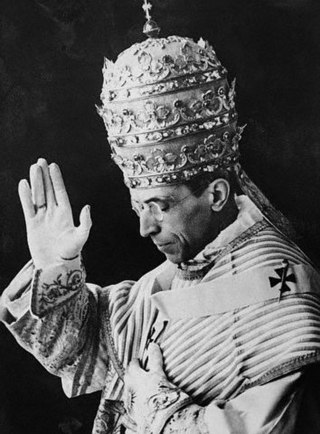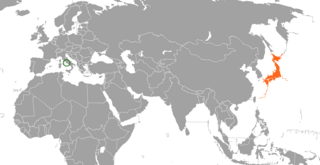
Pope Pius XII, born Eugenio Maria Giuseppe Giovanni Pacelli, was head of the Catholic Church and sovereign of the Vatican City State from 2 March 1939 until his death in October 1958. Before his election to the papacy, he served as secretary of the Department of Extraordinary Ecclesiastical Affairs, papal nuncio to Germany, and Cardinal Secretary of State, in which capacity he worked to conclude treaties with European and Latin American nations, including the Reichskonkordat with the German Reich.

Pope Benedict XV, born Giacomo Paolo Giovanni Battista della Chiesa, was head of the Catholic Church from 1914 until his death in January 1922. His pontificate was largely overshadowed by World War I and its political, social, and humanitarian consequences in Europe.

Pope Pius XI, born Ambrogio Damiano Achille Ratti, was head of the Catholic Church from 6 February 1922 to 10 February 1939. He also became the first sovereign of Vatican City upon its creation as an independent state on 11 February 1929 where he held that position in addition to being the leader of the Catholic Church until his death in February 1939. He assumed as his papal motto "Pax Christi in Regno Christi", translated "The Peace of Christ in the Kingdom of Christ".
In Christianity, inculturation is the adaptation of Christian teachings and practices to cultures. This is a term that is generally used by Catholics, whereas Protestants, especially associated with the World Council of Churches, prefer to use the term "contextual theology".
Mystici Corporis Christi(The Mystical Body of Christ) is an encyclical issued by Pope Pius XII on 29 June 1943 during World War II. Its main topic is the Catholic Church as the Mystical Body of Christ.

Summi Pontificatus is an encyclical of Pope Pius XII published on 20 October 1939. The encyclical is subtitled "on the unity of human society". It was the first encyclical of Pius XII and was seen as setting "a tone" for his papacy. It critiques major errors at the time, such as ideologies of racism, cultural superiority and the totalitarian state. It also sets the theological framework for future encyclical letters, such as Mystici corporis Christi (1943). The encyclical laments the destruction of Poland, denounces the Molotov–Ribbentrop Pact, and calls for a restoration of independent Poland.
Missionary work of the Catholic Church has often been undertaken outside the geographically defined parishes and dioceses by religious orders who have people and material resources to spare, and some of which specialized in missions. Eventually, parishes and dioceses would be organized worldwide, often after an intermediate phase as an apostolic prefecture or apostolic vicariate. Catholic mission has predominantly been carried out by the Latin Church in practice.
The Church policies after World War II of Pope Pius XII focused on material aid to war-torn Europe, the internationalization of the Roman Catholic Church, its persecution in Eastern Europe, China and Vietnam, and relations with the United States and the emerging European Union.
Pope Pius XII and the Church in China involves relations of the Holy See with China from 1939 to 1958. The Vatican recognized Chinese rites in 1939, elevated the first Chinese cardinal in 1946, and established a Chinese hierarchy.
Evangelii praecones was an encyclical letter of Pope Pius XII about Catholic missions. In it, he described necessary improvements and changes, and the persecution of the Church in some parts of the world. The encyclical was issued in commemoration of the 25th anniversary of the encyclical Rerum ecclesiae by his predecessor Pope Pius XI.
Persecutions against the Catholic Church took place during the papacy of Pope Pius XII (1939–1958). Pius' reign coincided with World War II (1939–1945), followed by the commencement of the Cold War and the accelerating European decolonisation. During his papacy, the Catholic Church faced persecution under Fascist and Communist governments.

The theology of Pope Pius XII is reflected in his forty-one encyclicals, as well as speeches and nearly 1000 messages, during his almost 20-year pontificate. The encyclicals Mystici corporis and Mediator Dei advanced the understanding of membership and participation in the Catholic Church. The encyclical Divino afflante Spiritu began opening the door to historical-critical biblical studies. But his magisterium was far larger and is difficult to summarize. In numerous speeches Catholic teaching is related to various aspects of life, education, medicine, politics, war and peace, the life of saints, Mary, the mother of God, things eternal and temporal.

The Mariology of the popes is the theological study of the influence that the popes have had on the development, formulation and transformation of the Roman Catholic Church's doctrines and devotions relating to the Blessed Virgin Mary.
The tradition of the Catholic Church claims it began with Jesus Christ and his teachings; the Catholic tradition considers that the Church is a continuation of the early Christian community established by the Disciples of Jesus. The Church considers its bishops to be the successors to Jesus's apostles and the Church's leader, the Bishop of Rome, to be the sole successor to Saint Peter who ministered in Rome in the first century AD after his appointment by Jesus as head of the Church. By the end of the 2nd century, bishops began congregating in regional synods to resolve doctrinal and policy issues. Historian Eamon Duffy claims that by the 3rd century, the church at Rome might even function as a court of appeal on doctrinal issues.

Catholic Marian movements and societies have developed from the veneration of the Blessed Virgin Mary by members of the Catholic Church. These societies form part of the fabric of Mariology in the Catholic Church. Popular membership in Marian organizations grew significantly in the 20th century, as apparitions such as Our Lady of Fátima gave rise to societies with millions of members, and today many Marian societies exist around the world. This article reviews the major Marian movements and organizations.
Maximum illud is an apostolic letter issued by Pope Benedict XV on 30 November 1919. As is traditional with such documents, it takes its title from the opening words of the original Latin text, meaning "that momentous". Benedict begins by recalling "that momentous and holy charge" found in Mark 16:15: "Go into the whole world and preach the gospel to all creation."
The Roman Catholic Church in the 20th century had to respond to the challenge of increasing secularization of Western society and persecution resulting from great social unrest and revolutions in several countries. It instituted many reforms, particularly in the 1970s under the Vatican II Council, in order to modernize practices and positions. In this period, Catholic missionaries in the Far East worked to improve education and health care, while evangelizing peoples and attracting numerous followers in China, Taiwan, Korea, and Japan.

The Concordat of 1940 was an agreement between Portugal and the Holy See of the Catholic Church signed in the Vatican on 7 May 1940 under António de Oliveira Salazar's Estado Novo. The 1940 concordat was kept in place until 2004 when a new one was signed by Prime Minister José Manuel Barroso. Salazar's text outlived him and outlived his regime for 30 years. The text was ratified in 1975, after the Carnation Revolution, only slightly amended in order to allow civil divorce in Catholic marriages, while keeping all the other articles in force.

The relations between the Holy See and Japan were informally established in 1919, when the Japanese government accepted a request by the Holy See to send an apostolic delegate to their country. It was not until 1942 that Japan began full diplomatic relations between the two states, making Japan the first Asian country to do so, and not until 1958 that the Japanese mission to the Vatican in Rome was upgraded to an embassy. The decision was made by Emperor Showa during World War II, hoping that the Vatican could serve as a mediator for negotiations between Japan and the Allies.









